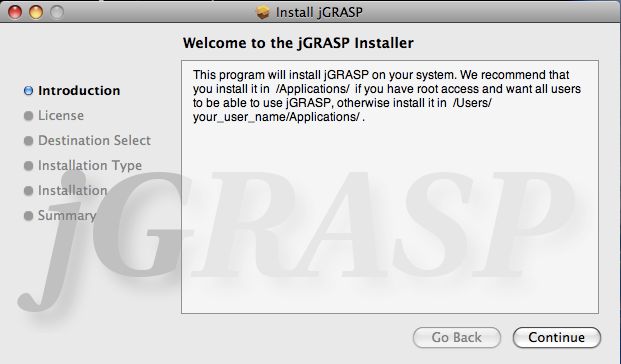Jgrasp For Mac
JGRASP is a lightweight development environment created specifically to provide automatic generation of software visualizations to improve the comprehensibility of software. JGRASP is implemented in Java, and runs on all platforms with a Java Virtual Machine (Java version 1.5 or higher). JGRASP produces Control Structure Diagrams (CSDs) for Java, C, C, Objective-C, Python, Ada, and VHDL; Complexity Profile Graphs (CPGs) for Java and Ada; UML class diagrams for Java; and has dynamic object viewers and a viewer canvas that work in conjunction with an integrated debugger and workbench for Java. The viewers include a data structure identifier mechanism which recognizes objects that represent traditional data structures such as stacks, queues, linked lists, binary trees, and hash tables, and then displays them in an intuitive textbook-like presentation view.
JGRASP is developed by the Department of Computer Science and Software Engineering in the Samuel Ginn College of Engineering at Auburn University. A new Viewer Canvas for Java that allows multiple viewers to be placed in one window, and the open viewers and viewer settings to be saved to file and to persist between debugging sessions. Unicode support with the ability to manually specify the encoding (if something other than the system default is needed) when opening or saving a file. Support for Python, including CSD generation. Project management for C, C, Objective-C, and Ada: the ability to compile and link multiple files without creating a makefile and support for separate source and binary directories.


Changes to the CSD so that with the CSD removed the code is formatted with standard 3 space indentation. There are no longer 3 leading spaces on all code.
Putty equivalent for mac. Exception handlers no longer have an 'extra' level of indentation. The new CSD generator will attempt to correct for code with leading space (code indented with CSD generation in older versions of jGRASP) and for code with an indent size different from 3 spaces.
4 Installation of Xcode and jGrasp Installation is fairly straightforward:. Install Xcode. Install jGrasp.
Run jGrasp. Click on Settings, pull down to Compiler Settings, and pull down to Workspace.
Change the language to C. Select 'c (g) - Mac OS X' or 'g - generic', click on Use, and click on OK. You are now ready to start developing in C/C and you have two ways to proceed, depending on your personal preferences.
Jgrasp Download For Mac
You can use jGrasp as your IDE or you can use Xcode as your IDE. 6 Working from within jGrasp You can compile, link and run applications written in C from within jGrasp. However, because of the nature of the C development process, it is not as simple as it is with applications written in Java. The Build menu contains the entries Compile, Compile and Link, Make, and Run (among others). The Compile entry can be used to compile an individual source file. The Compile and Link entry is not very useful because the process of indicating which files should be linked is akward.
Hence, it is best to use the Make entry. The Make entry simply calls the (which must be in your path - see the discussion in the installation instructions above). The make utility uses a makefile (with a default name of makefile) in the working directory. You can, of course, create/edit this file with jGrasp. Note that when you run an application from withing jGrasp it assumes that the executable is named a.out.